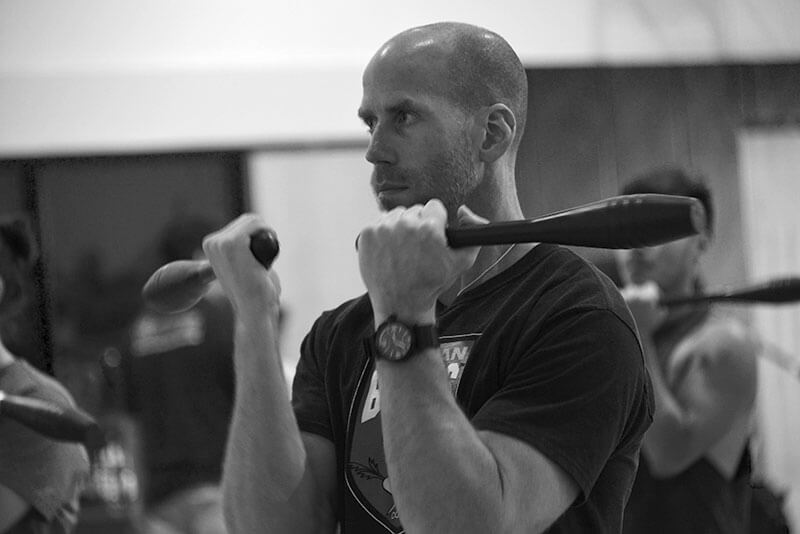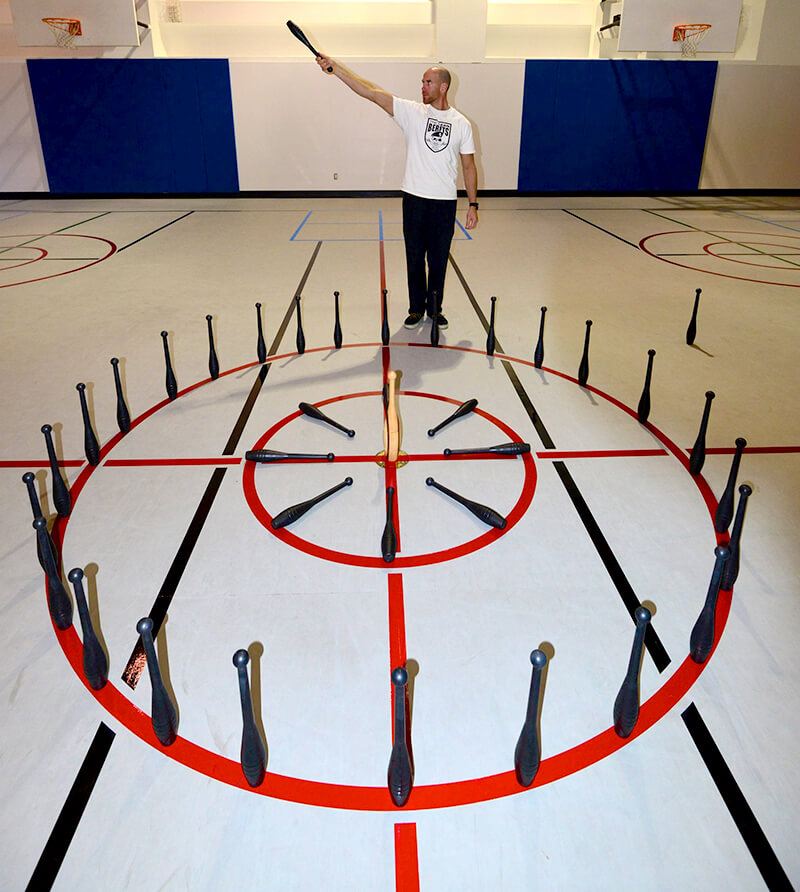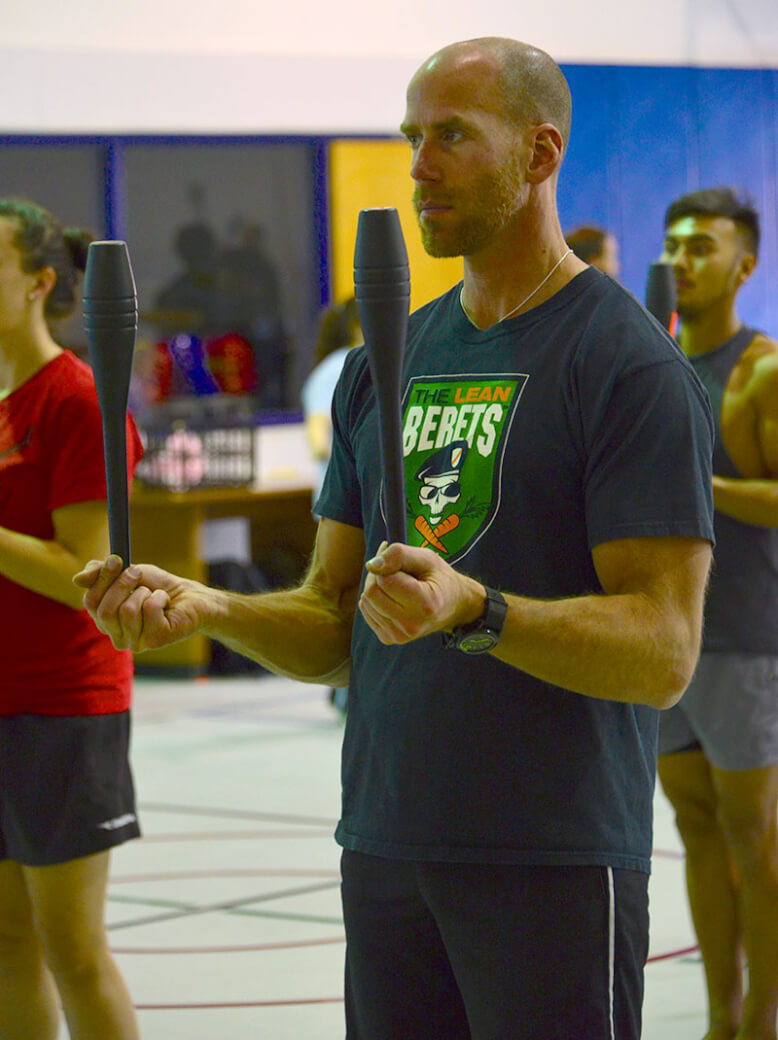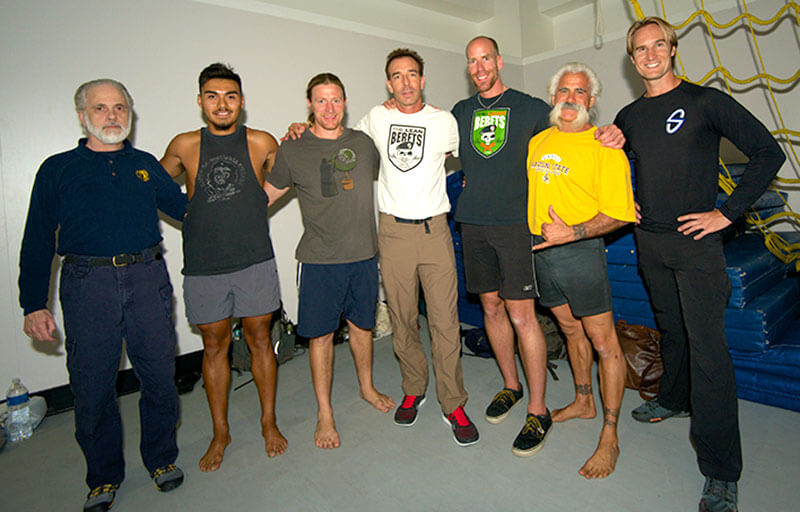Kevin Rail
Kevin Rail’s main profession is personal training and freelance writing. He is also a Special Ops Director of The Lean Berets, including product and label investigation, creation of Firing Squad and Gut Check videos, shopping tours and education on proper movement patterns in and out of the gym. In his spare time, he likes to build workouts for people based specifically on their individual situations and doesn’t believe one size fits all.
Talking to Kevin Rail. I had the pleasure of meeting Kevin Rail at a workshop in California during my Indian Clubs World Tour 2015.

When did you start swinging Indian Clubs?
Kevin Rail:- I started swinging Indian clubs about five years ago. I was highly influenced by Ron Jones, Richard “Army” Maguire, Paul Taras Wolkowinski and Dr Ed Thomas. I basically took bits and pieces from everyone and crafted my own style from there.
What sparked your interest in Indian Club Swinging?
Kevin Rail:- I am a big fan of complex movement patterns. I really like the idea of having to actually think about the position of your hands and feet while you do an exercise. It doesn’t take much skill or effort to sit on a machine and figure out how to push or pull levers in a linear fashion. This is not only boring, but it doesn’t cause much excitation in the brain synapses.
Then you have Indian clubs. Before I started using them, I began developing my own exercises and creating catchy titles that had my own name attached. They have since caught on in my group classes and with individual clients. In my never-ending pursuit of furthering my brain stimulation, I came upon Indian clubs and was in love at first swing. I knew I had to learn how to use these tools so as I say on the streets, it was on like Donkey Kong!
Can you explain why you enjoy Indian Club exercise?
Kevin Rail:- My enjoyment of Indian clubs goes well beyond the obvious reasons. I’d first and foremost like to say that when I started using them, I had a nagging shoulder injury. Since I tend to be pretty stubborn, I just kept working through it and never missed a step with my workouts. However, I had a really hard time sleeping on my left side. I literally spent months all contorted and crunched up in an awkward position in an effort to keep stress off my shoulder.
Then after I learned the basic first pattern with the clubs, things started to change. Literally, within about 10 days, I went to bed one night and slept on my left side with my shoulder against the bed. I woke up one day, a few days afterwards and realised my pain was gone. They have been a daily practice in my regimen ever since.
Aside from the injury correction, I also love the mental challenge, the better range of motion I’ve developed, my improved posture and functional ability. Right now at age 43 I can throw a football 60 yards on a frozen rope and I play third base in a competitive kickball league. I can throw laser beams from third base and I arguably have the strongest arm on the team.
Lastly, Indian clubs make me happy. A lot can be said about the neural load and physical development they cause, but no one talks about the endorphin rush.
I think it has to do with the fact that you have to concentrate hard on what you are doing. I would compare this to the endorphin rush or “runner’s high” that you often hear about.
Do you swing Indian Clubs one or two-handed?
Kevin Rail:- I always alternate back and forth between one and two clubs. Each practice brings multiple benefits to the body and they both have practical applications. For example, when you use one club, you can mimic throwing motions and racket sports patterns to a tee.
I also use a single meel all the time. The one I use is 11 lbs. and pretty heavy for a beginner. But for me, it feels really good.

If you were to be cast away alone on a desert island, which pair of Indian Clubs would you choose to have with you?
Kevin Rail:- If I was stranded on a desert island, my clubs of choice would be a pair of 1 and 2 lb, British style oak. Revolution Clubs have really nice ones.
What are the characteristics of your favourite Indian Clubs?
Kevin Rail:- I like clubs that are not too slender. I like a nice round knob at the bottom with a fatter barrel. I have big hands so these are easier to grip with wrist twirls and reverse switches behind the back.
I’m not a fan of the teardrop-shaped clubs. I guess my reasoning is a bit petty, but I have to be honest. Hahaha! I like to stand my clubs up against a wall when I’m not using them. I don’t have hanging racks so when they’re not in use, they’re either in my carrying case in my car or standing up by a wall. The regular style are flat at the top so it makes this easy.

Why did you decide to become an Indian Club trainer?
Kevin Rail:- My mission in life is to make people better at what they like to do outside the gym. In my town, everyone has a fitness passion that goes beyond the typical “3 sets of 10” mentality. They are hardcore bikers, hikers, downhill and cross-country skiers, mixed martial artists, runners, tennis players and swimmers.
My objective when I work with them is to find out which activity is their labour of love and help improve their performance at it. Even if that is being a full-time mom. When it comes to achieving this goal, no other tool even comes close to Indian clubs. That’s why I decided to become an Indian club trainer too.
What are the clubs swinging benefits for people?
Kevin Rail:- I went over my personal benefits from the clubs, but I’ll elaborate a little more for the average person…
- Better flexibility of the wrist, elbow and shoulder
- Improved brain function
- Injury prevention and correction of the rotator cuff especially
- Faster healing from injuries involved with the wrist, elbow and shoulder
- Improved posture
- Pain relief in the arms and shoulders
How do you combine Indian Clubs with other training?
Kevin Rail:- I probably use the clubs a little differently than the average person. I have a very hybrid approach to working out. I do a blend of restorative techniques along with kettlebells, off-the-ground training, on-the-ground training, dumbbells and body weight. My workouts are intense, but never without executing at least 90% quality with everything I do.
The Indian clubs come into play during my rest breaks. I really never take passive rest breaks when I train. Instead, I do active recovery. I pick up the clubs and spin them around in between sets. This was a major ‘aha’ moment I had a few years back. It occurred to me that by swinging clubs, I was flushing lactic acid out of my muscles really quick, which allowed me to recover faster and better. Couple that with the fact that they strengthen ligaments and tendons better than lifting alone, and improve range of motion, and I was sold for life. The same can be said for the Meel.
I do just practice the clubs and meel alone as well. It’s always in addition to the work I do between sets. The cool thing is, this technique works well for practising individual patterns. I will sometimes do five or more different patterns in a workout or blend multiple ones together. It’s a way to get a lot of practice while boosting your performance in your other exercises.
They are also fantastic for warming up before sports activities and general workouts.

Out of all the old books written about Indian Clubs, which one is your favourite and why?
Kevin Rail:- I don’t really have a favourite book actually. I spent a little time looking through The Indian Club Exercise by Sim D. Kehoe but got a little frustrated. Not that it’s a bad book, or that any other Indian club book is bad, but the illustrations are really hard to figure out. You see a lot of dotted lines and there are explanations on how to move them, but I feel the only way to truly learn is through onsite instruction from someone in front of you in real-time.
That being said, now that I know my way around the clubs better, I probably should seek out an old-school book and read it. My mind is like a sponge and I’m always up for broadening my horizons. I might be able to decode things better too.

Group photograph from a Dr Ed Thomas workshop
Is there anything else you would like to share?
Kevin Rail:- A lot of people are intimidated to work out because they don’t have an hour or even 30 minutes of free time. This is especially the case in the corporate sector. The great thing about clubs is the fact that once you learn a single basic pattern, you can experience benefits in 30 to 60 seconds! I’ve heard every excuse in the book for people not to exercise, but I feel everyone has at least one minute in the middle of the afternoon to reset their shoulders and brain.
Location:- Kevin Rail is based in Park City, UT

